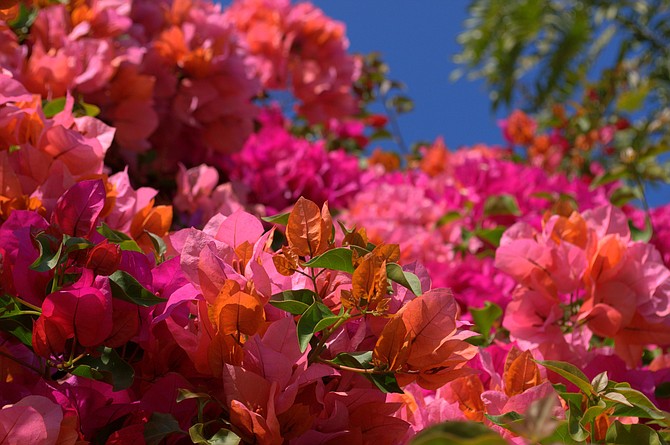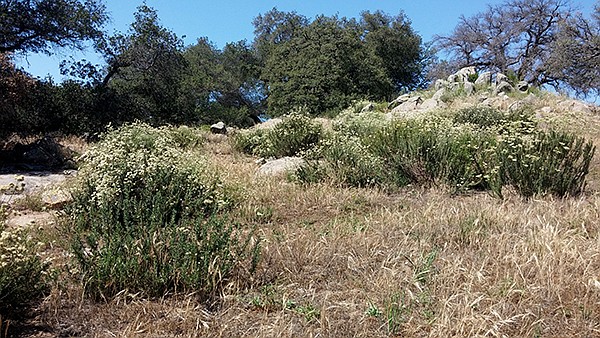 Facebook
Facebook
 X
X
 Instagram
Instagram
 TikTok
TikTok
 Youtube
Youtube

Colorful Foliage along San Diego’s coastline lingers, despite the lack of rainfall and warmer, drier days. In the older, landscaped neighborhoods of Coronado, Point Loma, Pacific Beach, and La Jolla, you’ll find oleander and hibiscus blooming in many shades and colorful bougainvillea creeping over garden walls. Look for the magnificent clusters of red flowers adorning the crowns of the flame eucalyptus (red-flowering gum) trees.
Agaves (a.k.a. century plants) are coming into bloom in many summer gardens this month. After a decade or more (not a century) of growth, the larger kinds of agave send up a tall, yellow-blossomed flower stalk from a base of fleshy, succulent, thorn-tipped leaves. The stalk and basal leaves die, but suckers make new plants and begin the cycle anew.

Buckwheat, a late-bloomer among native plants in our area, is showing off its small, inconspicuous clusters of cream-colored flowers this month. Several kinds of buckwheat, found in dry, sunny locations throughout San Diego County, are the source of the “wild buckwheat” honey sold locally. Near the coast look for flattop buckwheat, common on southfacing slopes. Here it shares space with other low-growing shrubs of the sage-scrub plant community like black sage and California sagebrush.
Last-quarter Moon (exact at 2:11 pm). The Moon rises around 1 a.m. tonight daylight-saving time, shining at the Cetus-Pisces border. Any time from then until early dawn, look high above the Moon for the Great Square of Pegasus standing on one corner.
Venus shines low in the west-northwest during twilight, with vastly fainter Mars now just 6° to its upper left. They set before twilight’s end. Venus hardly moves now with respect to your landscape from week to week, but its background stars are sliding right along, toward the lower right. On July 2nd the Beehive Cluster, M44, passes behind Venus. Try binoculars or a wide-field scope — but this will be a difficult observation if it’s possible at all! You’ll have to catch the narrow time window between the sky being too bright and Venus and the Beehive getting too low and setting. That window may or may not exist, depending on your optics, the sharpness of your eyes for faint stars in twilight, and the clarity of the air.
The above comes from the Outdoors listings in the Reader compiled by Jerry Schad, author of Afoot & Afield in San Diego County. Schad died in 2011. Planet information from SkyandTelescope.org.


Colorful Foliage along San Diego’s coastline lingers, despite the lack of rainfall and warmer, drier days. In the older, landscaped neighborhoods of Coronado, Point Loma, Pacific Beach, and La Jolla, you’ll find oleander and hibiscus blooming in many shades and colorful bougainvillea creeping over garden walls. Look for the magnificent clusters of red flowers adorning the crowns of the flame eucalyptus (red-flowering gum) trees.
Agaves (a.k.a. century plants) are coming into bloom in many summer gardens this month. After a decade or more (not a century) of growth, the larger kinds of agave send up a tall, yellow-blossomed flower stalk from a base of fleshy, succulent, thorn-tipped leaves. The stalk and basal leaves die, but suckers make new plants and begin the cycle anew.

Buckwheat, a late-bloomer among native plants in our area, is showing off its small, inconspicuous clusters of cream-colored flowers this month. Several kinds of buckwheat, found in dry, sunny locations throughout San Diego County, are the source of the “wild buckwheat” honey sold locally. Near the coast look for flattop buckwheat, common on southfacing slopes. Here it shares space with other low-growing shrubs of the sage-scrub plant community like black sage and California sagebrush.
Last-quarter Moon (exact at 2:11 pm). The Moon rises around 1 a.m. tonight daylight-saving time, shining at the Cetus-Pisces border. Any time from then until early dawn, look high above the Moon for the Great Square of Pegasus standing on one corner.
Venus shines low in the west-northwest during twilight, with vastly fainter Mars now just 6° to its upper left. They set before twilight’s end. Venus hardly moves now with respect to your landscape from week to week, but its background stars are sliding right along, toward the lower right. On July 2nd the Beehive Cluster, M44, passes behind Venus. Try binoculars or a wide-field scope — but this will be a difficult observation if it’s possible at all! You’ll have to catch the narrow time window between the sky being too bright and Venus and the Beehive getting too low and setting. That window may or may not exist, depending on your optics, the sharpness of your eyes for faint stars in twilight, and the clarity of the air.
The above comes from the Outdoors listings in the Reader compiled by Jerry Schad, author of Afoot & Afield in San Diego County. Schad died in 2011. Planet information from SkyandTelescope.org.
Comments